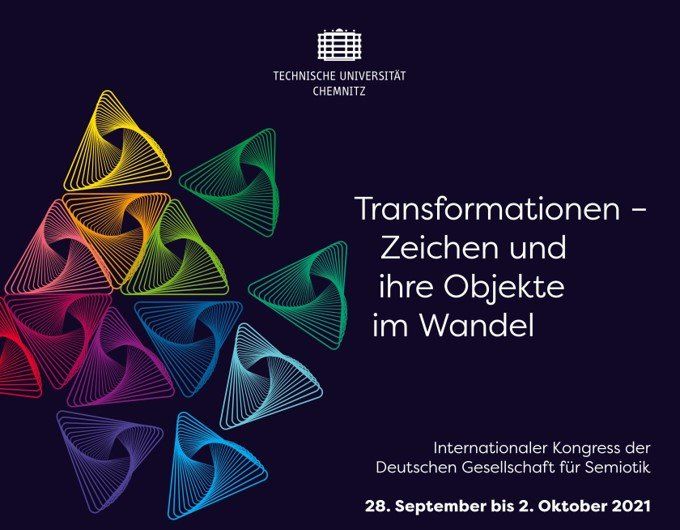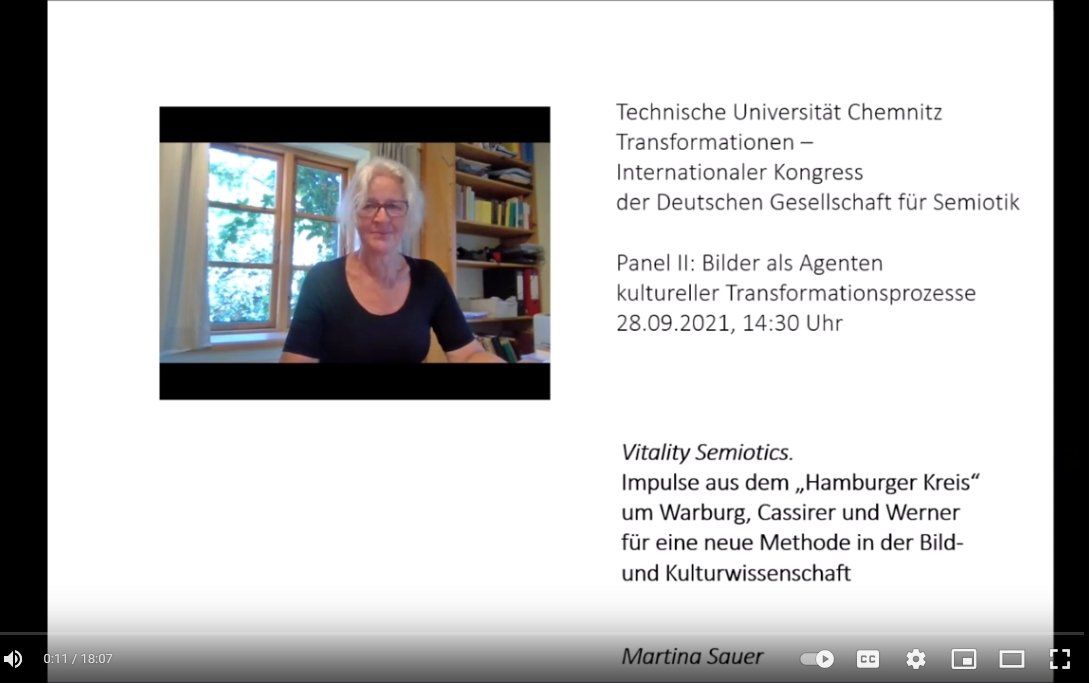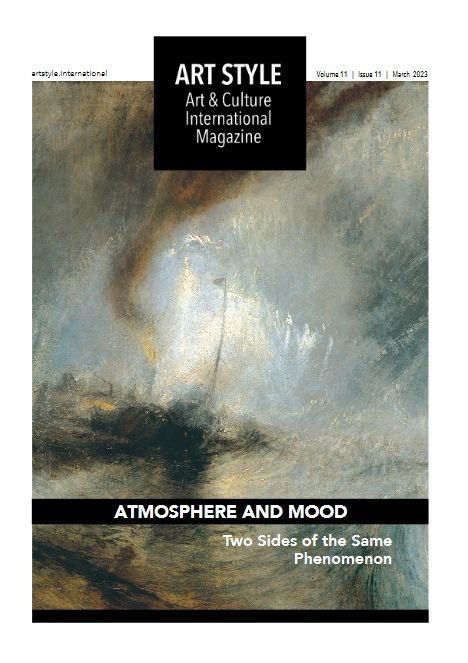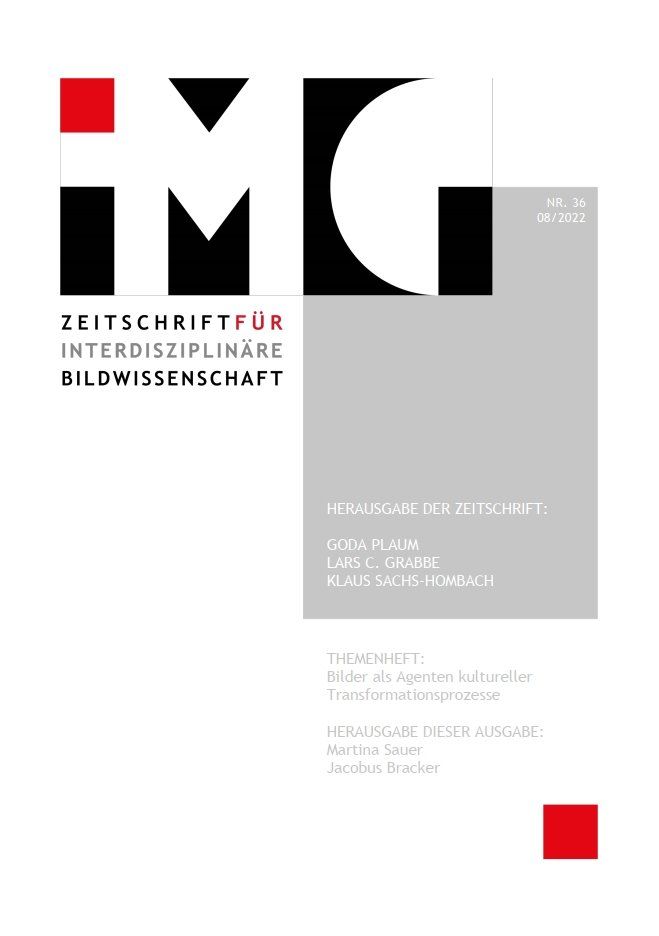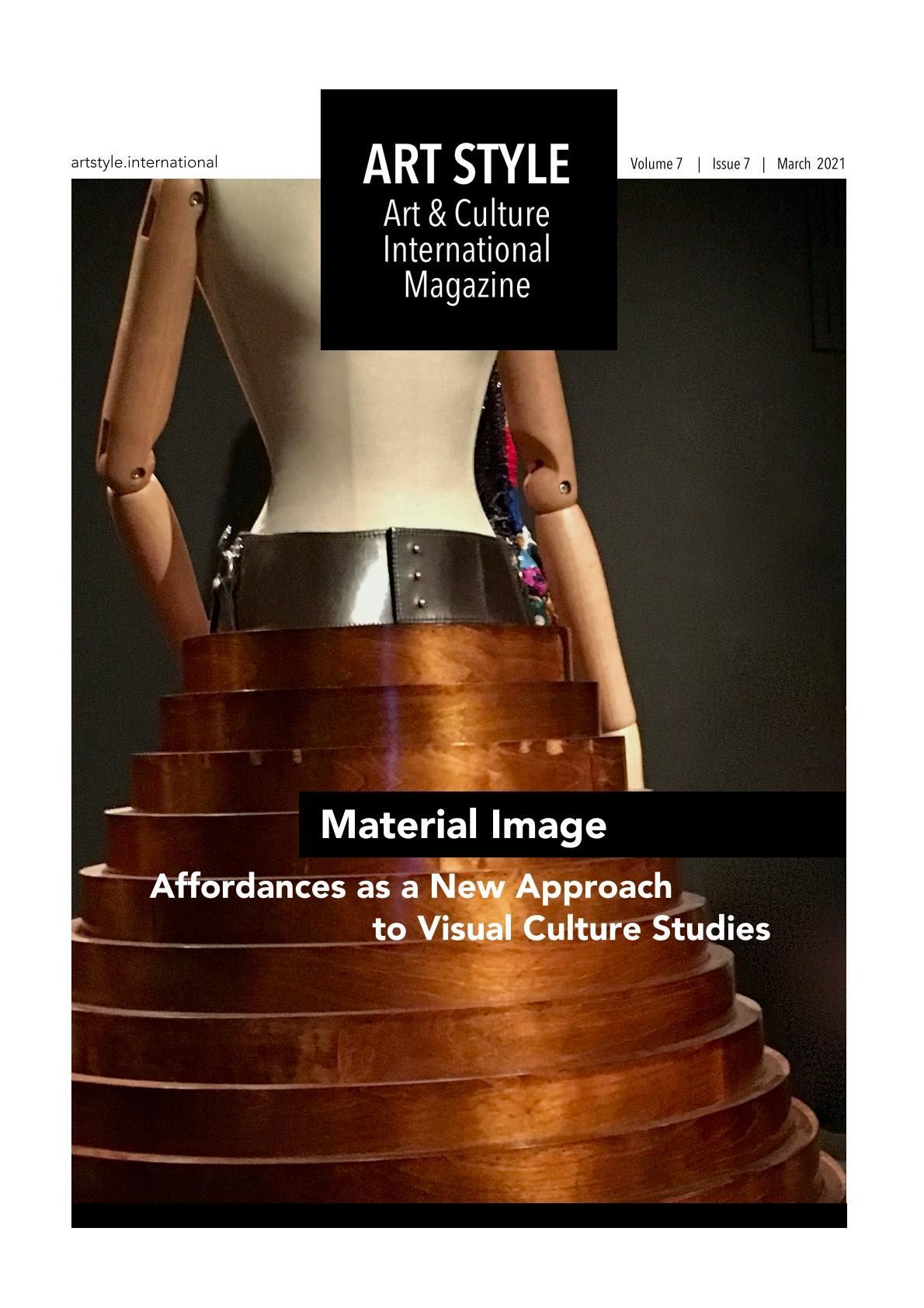News
Education and training seminars and lectures for academies, educational portals, philosophical salons and universities:
Video Lectures
YouTube: 20-miniute talk on Vitality Semiotics and
Katharina Sievering, 28.09.2021;
in English:
https://youtu.be/MuB90eXfgOQ
YouTube: 20-Minuten Vortrag über Vitality Semiotics und
Katharina Sievering, 28.09.2021;
auf Deutsch:
https://www.youtube.com/watch?v=JC0jI51GeMw&t=139s
Coming and Last Public Lectures
In Rastatt/Baden, 05.10.2024, Schloss Favorite, Rastatt, private, lecture on "Sie haben es sogar liebgewonnen” (Kant 1784). Über Rollenmodelle von Frauen (und Männern)
In Landau,
24.-28.09.2024, 24.-28.09.2024, RPTU in Landau (Rheinland-Pfälzische Technische Universität),
Keynote speech by Martina Sauer (image scientist) and Giuseppe Di Cesarewith the neuroscientist Giuseppe Di Cesare from Italy, at the
International Conference of the German Society of Semiotics about "Signs.Cultures.Digitalities": on "Vitality forms in action, speech, and design: a powerful communication tool for social interactions"Keynote speech der Bildwissenschaftlerin aus Deutschland Martina Sauer und des Neurowissenschaftlers aus Italien Giuseppe Di Cesare über:
Vitality forms in action, speech, and design: a powerful communication tool for social interactions
auf der internationalen Konferenz der Deutschen Gesellschaft für Semiotik
über
"Zeichen.Kulturen.Digitalität"
an der RPTU (Rheinland-Pfälzische Technische Universität)
In Italien, Rom, 25. World Congress of Philosophy, Rom, 1.-8.08. 2024, Round-Table des Langer-Circle, Talk on Towards Vitality Semiotics and a New Understanding of the Conditio Humana in Susanne K. Langer
In Münster, 23.05. – 25.05.2024, Vortrag über Lady Gaga: Storytelling von Frau & Körper im postfaktischen Zeitalter auf dem Symposium der Münster School of Design in Kooperation mit der Universität Regensburgder über "Storytelling/Transdisziplinär – Symposium Crossmediale Ästhetiken und postmoderne Mythenmaschinen: Bildkritik und Kommunikation im postfaktischen Zeitalter"
In China, 16.-17.09.2022, Invited Speaker, Online International Conference in China on Aesthetics of Atmosphere in an Intercultural Perspective, College of Media and International Culture at Zhejiang University,
College of Liberal Arts, Guangxi University for Nationalities at Guangxi University, lecture on lecture on
Vitality Semiotics: The Ever Beautiful and its Potential for an Intercultural Approach (publication in 2024, forthc.)
Blog
April 03, 2024:
Methodology from art historical practice: Iconology - origins and outlook
Guided Tours
Guided thematic tours on art and philosophy
at the Museum Frieder Burda, Baden-Baden
German and English, 60 min.
March, 2, 2024 to May 26, 2024
ImPossible.
Art can give shape to the impossible. For what reason?
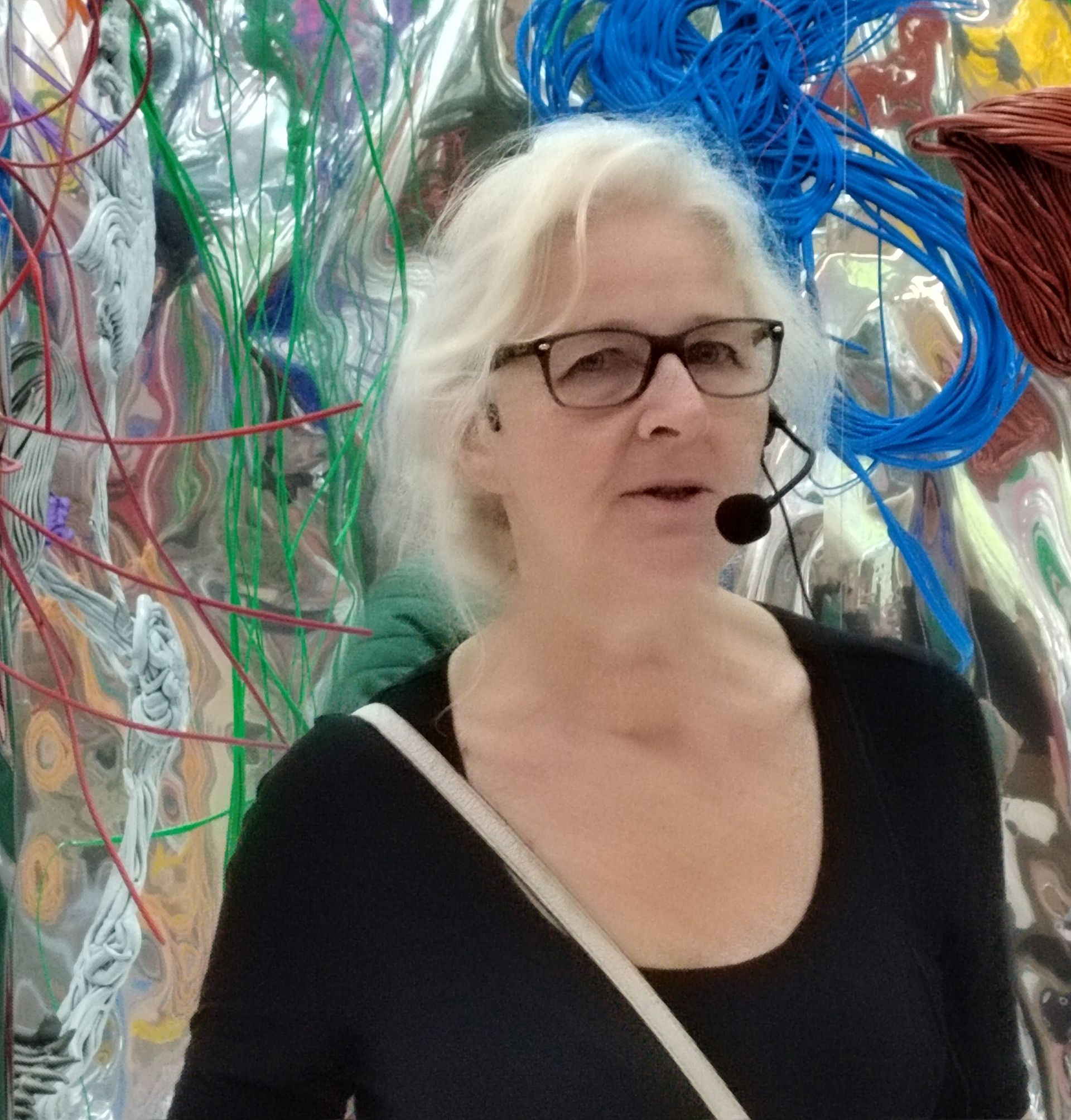
Guided tour through
ImPossible
- here in Daniel Knorr's specially staged exhibition room - with Dr. Martina Sauer at Museum Frieder Burda. Photo: Marie-Christine Heck, 22.03.2024
Art can give shape to the
ImPossible, as the
Frieder Burda Museum
flyer for the exhibition
ImPossible states:
What is it good for? What's behind it? The tour through the exhibition follows traces from philosophy and art that can provide answers.
Selection of Current Seminars
for Educational Institutions
Image - Culture -Philosophy
- 300 years Kant: Are we enlightened? Questions for Immanuel Kant today?
- Hilla von Rebay and Peggy Guggenheim
- Turner and Sensualism (John Ruskin)
- Metaverse
- Colonialism and Africa (Kant, Barthes, Butler)
- Russia and Communism from the First Hour in Images (Karl Marx)
- Russia: Post-Communism and Media (Marshall McLuhan)
- Myths, Fake News and Alternative Truths? Answers from Philosophy
- Political Myths: Anselm Kiefer
- What´s the point? When the familiar and the traditional are called into question by art and design (Walter Benjamin)
- "Anything goes". Postmodern architecture and its backgrounds in our world
- "Zaha Hadid flies away from the ordinary and far into the future." Postmodern architecture as an expression of the spirit of life today
- "Hamburger Kreis" 1919-1933. Consequences of the Exclusion of Jewish Scholars in Research and Teaching in Germany (Cassirer, Warburg, Werner)
- etc.
Activities at Universities and in Organizations
Art Style | Art & Culture International Magazine, New York / São Paulo
Senior Editor: https://artstyle.international/
#issue_10: edited by Martina Sauer & Christiane Wagner
Special issue on/read Multimodality: On The Sensually Organized and at The Same Time Meaningful and Socio-Culturally Relevant Potential of Artistic Works, pulished 07/2022
#issue_11: edited by Martina Sauer & Zhuofez Wang,
Special issue on/read Atmosphere and Mood. Two Sides of The Same Phenomenon, published 03/2023
Fresenius Hochschule, University of Applied Sciences, AMD Akademie Mode & Design Hamburg und Düsseldorf
Teaching and research assistant since 2021: https://www.amdnet.de/
Teaching 2023-24
SS 2024 Düsseldorf: online seminar on Basics on Perception and Design I: Approaches in natural science and cultural studies: differences, methods, and practice
WS 2023/24 Düsseldorf: online seminar on Basics on Perception and Design II: Approaches in natural science and cultural studies: differences, methods, and practice
Research project and educational film:
Sept. 24-28, 2024
international conference of the German Society for Semiotics, joint panel Image and Fashion (Prof. Dr. Petra Leutner AMD Hamburg) on:
Metaverse - AI and New Aesthetics? hybrid, D/En
Keynote speech by image scientist from Germany Martina Sauer and neuroscientist from Italy Giuseppe Di Cesare on
Vitality forms in action, speech, and design: a powerful communication tool for social interactions
CfP (deadline November 30, 2023): Call for Papers of the panel Image and Fashion, PDF here (hybrid)/ Martina Sauer (image) and Petra Leutner (fashion) on/read
Metaverse - AI and New Aesthetics?, hybrid, D/En, applications and queries to sauer@bildphilosphie.de (image) or pleutner@aol.com (fashion)
SS 2022 Research project on Affective Perception and Design together with AMD Hamburg / FB Design der Hochschule Fresenius: Prof. Dr. Petra Leutner and the Institute of Technology (IIT) Genoa/Parma, Italy, CONTACT lab, Dr. Giuseppe di Cesare and PhD student Giada Lombardi:
https://whisperproject.eu/team-lab-robot
June 13, 2022, 4 pm public guest lecture on
Affective Perception and Design
by Dr. Giuseppe di Cesare and PhD student Giada Lombardi, Genoa/Parma, Italy at Akademie Mode & Design, Fresenius Hochschule, University of Applied Sciences, Alte Rabenstrasse 1, 20148 Hamburg, Room 1.01 (1st floor)
SS 2022 Educational Film (intranet) on Margaret and Christine Wertheim. Value and Change of Corals, Museum Frieder Burda, Baden-Baden with Prof. Dr. Petra Leutner, AMD Hamburg
German Society for Semiotics (DGS)
Scientific Advisor and Co-Leader Section Image, Editor: http://www.semiotik.eu/?lang=en
CfP (Deadline March 3, 2024) Frames and Framing: Dynamic Nature and Material-Cognitive Interplays, edited by Natalia Igl & Martina Sauer, as a special issue in Zeitschrift für Semiotik, edited by Ellen Fricke und Martin Siefkes, Tübingen: Stauffenburg
Sept. 23-27, 2024, German Society of Semiotics (DGS), 17. International Conference: RPTU, Rheinland-Pfälzische Technische Universität in Landau on/read Signs.Cultures.Digitality
Keynote speech by the image scientist from Germany Martina Sauer and the neuro scientist from Italy Giuseppe Di Cesare on Vitality forms in action, speech, and design: a powerful communication tool for social interactions
Current CfP (Deadline November 30, 2023) of the panel Image and Fashion (hybrid) / Martina Sauer (Image) & Petra Leutner (Fashion) on/read Metaverse - AI and New Aesthetics?, application and inquiries to msauer@bildphilosphie.de (Image) or pleutner@aol.com (fashion)
08/2022, Release of the special issue of the Image Section at the 16th International Conference on Transformations at Chemnitz University of Technology on/read
Bilder als Agenten kultureller Transformationsprozesse, edited by Martina Sauer & Jacobus Bracker [special issue, IMAGE 36, 08, 2022]
Last Publications of Articles, Editions and Encyclopedia Contribution
- partially to download -
01/2024 Towards Vitality Semiotics and a New Understanding of the Conditio Humana in Susanne K. Langer, in: The Bloomsbury Handbook of Susanne K. Langer, edited by Lona Gaikis. London: Bloomsbury, Kapitel 15, 223—238
07/2023 Encyclopedia: Debatte zwischen spekulative Ästhetik versus Ästhetik als Formwissenschaft 1830-1870, in: Grundriss der Geschichte der Philosophie, Bd. 1/2, Die Philosophie des 19. Jahrhundert: Deutschsprachiger Raum 1830—1870, Hg. Gerald Hartung, § 16, 425—447, Basel: Schwabe 2023
05/2023
Interaction of Nature and Man after Ernst Cassirer: Expressive Phenomena as Indicators, in:
Critical Zone, edited by Jacobus Bracker und Stefanie Johns, 147—161 [Visual Past 7], Hamburg
03/2023 Giada Lombardi, Martina Sauer and Giuseppe Di Cesare, An Affective Perception: How ‘Vitality Forms’ Influence our Mood, in: Atmosphere and Mood. Two Sides of the Same Phenomenon, edited by Martina Sauer and Zhuofez Wang, 127—139 [Art Style 11]
Forthcoming Articles and Encyclopedia Contribution
Article on Vitality Semiotics: The Ever Beautiful and its Potential for an Intercultural Approach, in: Atmospheric Design and Everyday Aesthetics, edited by Yuriko Saito, David Brubaker, and Zhuofei Wang [Special Volume Contemporary Aesthetics 2], 2024
Encyclopedia:
Formale Ästhetik, in:
GIB. Glossar für Bildphilosophie
Last Publications of Books/E-Books
In past decades, the subject atmosphere and mood has gone beyond the physio-meteorological and psychological scopes and become a new direction of aesthetics which concerns two sides of the same phenomenon. As the primary sensuous reality constructed by both the perceiving subject and the perceived object, atmosphere and mood are neither a purely subjective state nor an objective thing. Atmosphere is essentially a quasi-object pervaded by a specific affective quality and a ubiquitous phenomenon forming the foundation of our outer life experiences, while mood is a quasi-subject pervaded by specific objective quality and thus a ubiquitous phenomenon forming the foundation of our inner life experiences. A practical dimension is thereby, from the outset, embedded in the consideration of both concepts. This is mainly characterized by actions and, correspondingly, ethical aspects, which concern the design and creation of atmosphere and thus the triggering of mood through works of art. Here, on the one hand, the process of artistic formation, long neglected in the European tradition, is given prominence as an aesthetic practice, and on the other hand, an interactive dialogue is effectively established between the artist, the work and the viewer. Due to the fact that atmosphere and mood, both as in-between, emphasize the interaction of the perceiver and the perceived from two sides, here the decisive question is: in what kind of environment do we live or participate and in what way do we experience it? The focus of aesthetics is now not on the conventional issue whether the environment is beautiful or gives us a sense of beauty, but on how the environment influences our feeling of being there (Befinden) through our own sensuality. Such an approach would contribute to a critical transformation in aesthetic methodology, namely from the ontological and/or epistemological what to the phenomenological and anthropological how.
The tension between atmosphere and mood, as revealed here, opens up a large space for exploring a new understanding of aesthetics. On this basis the special issue pursued to diversify this discussion on an international level.
Atmosphere and Mood: Two Sides of the Same Phenomenon, edited by Martina Sauer & Zhuofei Wang, New York & São Paulo [Special Issue, Art Style 11, 07, 2023]
With a Call for Essays, the special issue Multimodality sought contributions that accept not only the material but also the body-bound dependence of media perception and understanding. To this end, contributions were included that shed light on both the structural and signifying potential of artistic works through multimodal analysis. Particular attention was paid to contributions that clarify how the structural features - the modes - of the arts, their perception, and their signifying potential in terms of content are interrelated and how they are to be understood in communicative and thus socioculturally relevant terms. Thus, in addition to neuroscientific contributions, those from cultural anthropology, art history, image and art studies, and literary studies were included.
Multimodality. The Sensually Organized Potential of Artistic Works, edited by Martina Sauer & Christiane Wagner, New York & São Paulo [Special Issue, Art Style 10, 01, 2022]
2021 instead of 2020, the 16th international congress of the German Society for Semiotics took place on the topic of transformations. Due to the Corona pandemic, it was finally not held in presence at the TU Chemnitz, but took place online: http://www.semiotik.eu/transformationen-2020. 11 sections with different foci from archaeology, architecture, design, digital humanities, on the body, from the field of literature & youth and subcultures, media, fashion, environment and carto/atlas semiotics and sign philosophy had each published their own call for papers.
The Image & Cultural Studies sections addressed the research community with a German/English call on images as agents of cultural transformation processes. The focus of the call was to understand images as agents - in the words of art and cultural studies scholar Aby M. Warburg - and to recognize and understand not only their potential for cognition, but also their potential for action. As an active part of culture, they not only convey it, but at the same time stimulate action. In this respect, images can be understood not only as documents and testimonies of collective history, but also assume an active role as carriers and repositories of affectively effective elements of communication. As agents of cultural transformation processes, images take on a status of their own within the human capacity for expression and action. The essays in this volume bear eloquent witness to this.
Images as Agents of Cultural Transformation Processes, edited by Martina Sauer & Jacobus Bracker, New York & São Paulo: Special Issue, IMAGE 36, 08, 2022
This special issue on affordances bases on the thesis, that all natural and artificial things inhere affordances that appeal to our cognitive system, and thus invite us to look at them, perceive them, think about them, interpret them, and use them.The concept roots in the studies of the American psychologist James J. Gibson from the 1960s. According to him, "things" offer a certain range of possible activities depending on their form, time patterns, and material qualities, thus becoming part of human-thing-interactions. However, affordances can also be culturally trained. This aspect has been intensively discussed subsequently within different disciplines (e.g., Social Sciences, Design Studies). But only recently has the concept received attention in the field of Visual Culture Studies particularly through archaeological scholarship.
As the articles of this special issue show, this approach is now gaining momentum in a broad range of image- and object-related disciplines. It may not surprise that the authors’ perspectives on images and objects vary widely within the issue. However, thanks to the use of affordances as a theoretical and/or methodological tool, they all contribute to fundamental questions of perceiving, receiving, understanding, as well as interpreting, and acting with sensuously present culture.
On The Material Image. Affordances as a New Approach to Visual Culture Studies, ed. by Elisabeth Günther & Martina Sauer, New York & São Paulo: Special Issue, Art Style, 7, 03, 2021
We live in the age of postmodernism. What does that mean? With a call for essays, we asked for proposals for a better understanding. At the same time, we were looking for posts that show how the arts have processed and are still processing the change from the modern to the postmodern selfconception of man, which has been described by philosophy since the 1950s to today. This special issue thus demonstrates how architects, designers and artists have reacted to the new socio-politically relevant concepts of postmodernism.
With contributions of Simone Kraft on architecture, Arianna Fantuzzi on self-portraits, Stephan Schmidt-Wulffen on visual arts in the 1980s, Anna Kristensson on design, Iris Laner on postmodern theory and the work of Jeff Wall, Christiane Wagner on postmodern avatars and finally, I expressed myself on the deconstruction of the familiar in postmodern theory and the work of Karin Kneffel.
On the Postmodern Age, edited by Martina Sauer, New York & São Paulo:
Special Issue, Art Style
6, 09, 2020
This first coherent monograph presented here on the life and work of the important Bauhaus master pursues the goal of rediscovering Josef Albers as an artist and educator.
Forty years after his death, the award is intended to honour an artist who had previously received too little attention in the ranks of the Bauhaus masters, especially in Germany. To present him alone as a teacher and provider of ideas for the preliminary course at the Bauhaus is not enough. After emigrating to the USA, he made his international breakthrough as an artist personality and subsequently revolutionized the art world both through his work and his work as a teacher.
Vgl. Review on
Amazon
Martina Sauer, Josef Albers, "So ist Kunst ... Erlebnis," with a foreword by Ulrike Growe, Josef Albers Museum Quadrat Bottrop and illustrated city tour in Weimar und Dessau [Bauhaus Personenreihe, edited by Elke Beilfuß, Wiesbaden: Weimarer Verlagsgesellschaft, 2018, 16,90 €
How do we perceive world, how do we perceive images?
The book is based on the assumption that we access the world like pictures, first of all through our sensations, and that there
is a direct connection between the two. In the discussion of fascination and horror that Anselm Kiefer's pictures of Germany can evoke, the author discusses the consequences and conclusions of this for our cultural self-image. Based on this, the author develops a new image and cultural theory within research, which also explains the special status of fine arts.
Hans and Lea Grundig Award 2015 of the Rosa Luxemburg Foundation, special appreciation to the first edition [Berlin, 26.11.2015]
Martina Sauer, Faszination - Schrecken.
Zur Handlungsrelevanz ästhetischer Erfahrung anhand Anselm Kiefers "Deutschlandbilder", 2. edn, Heidelberg: arthistoricum.net, 2018, Gebundenes Buch 36,90 €, Taschenbuch 26,90 €
PhD
Thesis
Do abstract pictures still convey meaning at all, and if so, which one? With the reduction of the pictorial arrangement to simple flecks in Cézanne, to strokes in van Gogh and smearing traces of colour in Monet, their significance is fundamentally questioned. If, on the other hand, these are understood as effective forces or impulse forces, a completely new, different sense opens up. Landscape is no longer imagined, but realized" in the aesthetic experience. Aesthetics or aisthetics (perception) therefore proves to be a concept of experience and knowledge. Thus the term "new" can also be used to describe the image: it can be described as an "energetic system".
Martina Sauer, Cézanne - van Gogh - Monet. Genese der Abstraktion, PhD Basel 1998, 2nd edn., Universitätsbibliothek Heidelberg: ART-Dok, 2014, 19,90 €
Institute for Image and Cultural Philosophy
Dr. Martina Sauer
Wörthstr. 1, D-77815 Bühl


